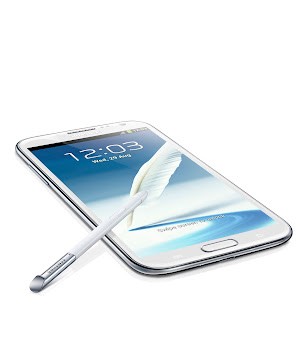
South Korean tech major Samsung unveiled its brand new Galaxy Note 2 at IFA in Berlin on Wednesday, and the new device is expected to hit around 128 markets worldwide this October.
The original Galaxy Note had garnered a lion's share in Samsung's robust growth in the smartphone market, and the company is presently revelling in its success while rolling out improved features in its Galaxy Note category in a bid to cash in its popularity.
After pushing out the much-sought-after Android 4.0 Ice Cream Sandwich OS for the Note in May this year, it also rolled out in August its improved version of Galaxy Note 10.1, which has a 10.1-inch large display with a multiscreen feature to enhance a user's multitasking experience.
And now with the improved Samsung Galaxy Note 2 unveiled, the phablet will soon be available for grabs. Before the launch, there were many speculations about Galaxy Note's successor, hinting at the possibility that the new device will come with blown-up specs and features.
Surprisingly, most of the rumoured features on the Galaxy Note 2 have fallen in place, from the Operating System to the other specs, except the camera of the new Note, which is bit of a letdown.
The Galaxy Note 2 has several tweaked features than its predecessor, and assures an improved and enhanced performance for its users.
Meanwhile, users of the original Galaxy Note are in sticky situation, and are faced with the same rhetorical question: is it worth upgrading to the new Galaxy Note 2?
Hence, here's a complete breakdown of key specs and features between the Galaxy Note and its heir to help decide if its worth buying the Galaxy Note 2 or to stick to the Galaxy Note.
Display: The Galaxy Note features a 5.3-inch Super AMOLED, 800 x 1280 capacitive touchscreen rugged with corning gorilla glass and multitouch. Whereas Galaxy Note 2 has a whopping 5.5-inch HD Super AMOLED with 1,280 x 720 resolution, which also offers multi-touch.
Operating System: This is one feature that helped Galaxy Note 2 score some points over its erstwhile version. The previous Note runs on Android 4.0, which is relatively old in the market with the introduction of Jelly Bean OS.
The Note is very unlikely to get the Jelly Bean update anytime soon, because its hardware is not compatible for Android's latest iteration.
On the other hand, Galaxy Note 2 comes with Android 4.1, codenamed Jelly bean, out-of-the-box. Jelly Bean also features a redesigned search experience, with a new user interface and faster Voice Search. Google said that the new OS includes new features which make everything feel fast, fluid, and smooth.
Processors and Memory: Galaxy Note packs a dual-core 1.4 GHz ARM Cortex-A9 coupled with 1GB RAM. It comes in two variants 16GB and 32GB of internal storage capacity, with expandable options via MicroSD card up to 32GB.
The Galaxy Note 2 has 1.6 GHz quad-core processor with 2GB RAM, which is quite enough to assure easy multitasking. It also comes in there variants of 16 GB, 32GB and 64GB of internal storage capacity, which is expandable up to 64GB via an external card.
Camera: The camera feature of the Galaxy Note 2 is bit of a letdown.
The new Note packs a 8-megapixel rear camera and a 1.9-megapixel front-facing camera with HD video recording. The Galaxy Note also has the 8-megapixel camera with a 2-megapixel front facing camera, scoring some points over its heir.
However, the Galaxy Note 2 shares some of the camera features with its compatriot Galaxy S3 smartphone, like Buddy Photo Share, Burst Shot and Best Photo
Earlier, speculation about the Galaxy Note 2 suggested that the device would come with a 12 or 13-megapixel primary camera.
Battery: The Galaxy Note packs a standard Li-Ion 2500 mAh battery that offers stand-by time up to 960 hours on 2G and up to 820 hours on 3G. It also offers talk-time up to 26 hours on 2G network and over 13 hours on 3G network.
On the other hand, the Galaxy Note 2 ships with a larger Li-ion 3,100mAh battery which assures improved services in stand-by and talk-time for longer hours.













!['It's not Mumbai traffic, it's air traffic': Suriya apologises to Mumbai media after paparazzi yelled At Him for making them wait for hours [Watch]](https://data1.ibtimes.co.in/en/full/806234/its-not-mumbai-traffic-its-air-traffic-suriya-apologises-mumbai-media-after-paparazzi.jpg?w=220&h=138)



